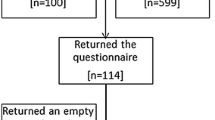Abstract
Objective
To assess the needs of patients with amyotrophic lateral sclerosis (ALS) and their families when being communicated the diagnosis.
Methods
We held a nationwide webinar in September 2020, titled “ALS Café”, and distributed a self-report questionnaire to participants.
Patients
This cross-sectional study included 56 respondents (patients, n = 32; family members, n = 24).
Results
Of the 56 respondents, 47 (84%) reported being anxious when they were communicated their diagnosis. The average time allocated for communicating the diagnosis was 36.3 ± 25.6 min, and 30% of respondents believed that insufficient time was allocated. Nearly half of the respondents were communicated their diagnosis by one physician, and 57% of the respondents received their diagnosis in one session. Approximately 80% of respondents received information about ventilators when they were being communicated their diagnosis, but most patients did not want to receive this information at that time. The anxious group tended to answer that the time to communicate the diagnosis was short. Meanwhile, all respondents in the mildly anxious group were provided with one or more information about the supportive contents along with the diagnosis. Moreover, in Japan, many patients with ALS and their families desire the legalization of euthanasia, which might affect decision-making.
Conclusions
This study shows that a longer amount of time spent communicating the diagnosis and provision of descriptions needed by patients and their families are important. This can help clinicians understand what the patient requires while being communicated their diagnosis.




Similar content being viewed by others
Abbreviations
- ALS:
-
Amyotrophic lateral sclerosis
- TIV:
-
Tracheostomy and invasive ventilator
References
Mitsumoto H, Chad DA, Pioro EP (1998) Amyotrophic lateral sclerosis. F.A. Davis Company, Philadelphia
Aoun SM, Breen LJ, Edis R et al (2016) Breaking the news of a diagnosis of motor neurone disease: a national survey of neurologists’ perspectives. J Neurol Sci 367:368–374. https://doi.org/10.1016/j.jns.2016.06.033
Aoun SM, Breen LJ, Howting D et al (2016) Receiving the news of a diagnosis of motor neurone disease: what does it take to make it better? Amyotroph Lateral Scler Frontotemporal Degener 17(3–4):168–178. https://doi.org/10.3109/21678421.2015.1111907
Ley P (1998) Communication with patients: improving communication, satisfaction and compliance. Croon Helm, London
Silverstein MD, Stocking CB, Antel JP, Beckwith J, Roos RP, Siegler M (1991) Amyotrophic lateral sclerosis and life-sustaining therapy: patients’ desire for information, participation in decision making, and life-sustaining therapy. Mayo Clin Proc 66:906–913. https://doi.org/10.1016/s0025-6196(12)61577-8
Baile WF, Buckman R, Lenzi R, Glober G, Beale EA, Kudelka AP (2000) SPIKES—a six-step protocol for delivering bad news: application to the patient with cancer. Oncologist 5(4):302–311. https://doi.org/10.1634/theoncologist.5-4-302
Anderson PM, Abrahams S, Borasio GD et al (2012) EFNS guidelines on the clinical management of amyotrophic lateral sclerosis (MALS)—revised report of an EFNS task force. Eur J Neurol 19(3):360–375. https://doi.org/10.1111/j.1468-1331.2011.03501.x
Vianello A, Concas A (2014) Tracheostomy ventilation in ALS: a Japanese bias. J Neurol Sci 344:3–4. https://doi.org/10.1016/j.jns.2014.06.050
Kanda Y (2013) Investigation of the freely available easy-to-use software ‘EZR’ for medical statistics. Bone Marrow Transplant 48:452–458. https://doi.org/10.1038/bmt.2012.244
Mccluskey L, Casarett D, Siderof A (2004) Breaking the news: a survey of ALS patients and their caregivers. Amyotroph Lateral Scler Other Motor Neuron Disord 5:131–135. https://doi.org/10.1080/14660820410020772
Borasio GD, Sloan R, Pongratz DE (1998) Breaking the news in amyotrophic lateral sclerosis. J Neurol Sci 160(suppl 1):S127–S133. https://doi.org/10.1016/s0022-510x(98)00211-1
Veldink JH, Wokke JHJ, Wal G, Vianney JMB, Berg LH (2002) Euthanasia and physician-assisted suicide among with amyotrophic lateral sclerosis in Netherlands. N Engl J Med 346(21):1638–1644. https://doi.org/10.1056/NEJMsa012739
Maessen M, Veldink JH, Onwuteaka-Philipsen BD et al (2014) Euthanasia and physician-assisted suicide in amyotrophic lateral sclerosis: a prospective study. J Neurol 261:1894–1901. https://doi.org/10.1007/s00415-014-7424-6
Acknowledgements
The authors would like to acknowledge Mrs. Yurika Okuma, executive assistant at the Department of Neurology, Toho University Faculty of Medicine, who supported this study.
Funding
This work was partially supported by Grants-in-Aid from the Research Committee of CNS Degenerative Disease, the Ministry of Health, Labour and Welfare of Japan.
Author information
Authors and Affiliations
Contributions
TH and OK performed and reviewed literature searches, interpreted, and drafted the manuscript, and have both agreed to be personally accountable for the accuracy and integrity of the entire work. TH, OK, YI, YN and SE created a questionnaire and conducted a questionnaire survey. TH, OK, and MS aggregated and analyzed the results of the questionnaire. All authors reviewed and revised the manuscript and approved the final manuscript.
Corresponding author
Ethics declarations
Conflict of interest
All the authors report no conflict of interest relevant to the manuscript.
Availability of data and material
The data that support the findings of this study are available on request from the corresponding author, OK. The data are not publicly available as that contain information that could compromise the privacy of research participants.
Ethics approval
This study was conducted in accordance with ethical standards of the Ethics Committee of the Toho University Omori Hospital (reference no. M20020) and the Declaration of Helsinki for biomedical research involving human subjects.
Informed consent
Informed consent was obtained from all participants.
Additional information
Publisher's Note
Springer Nature remains neutral with regard to jurisdictional claims in published maps and institutional affiliations.
Rights and permissions
About this article
Cite this article
Hirayama, T., Izumi, Y., Nakayama, Y. et al. Communicating the diagnosis: a survey of patients with amyotrophic lateral sclerosis and their families in Japan. Acta Neurol Belg 122, 471–478 (2022). https://doi.org/10.1007/s13760-021-01801-3
Received:
Accepted:
Published:
Issue Date:
DOI: https://doi.org/10.1007/s13760-021-01801-3




